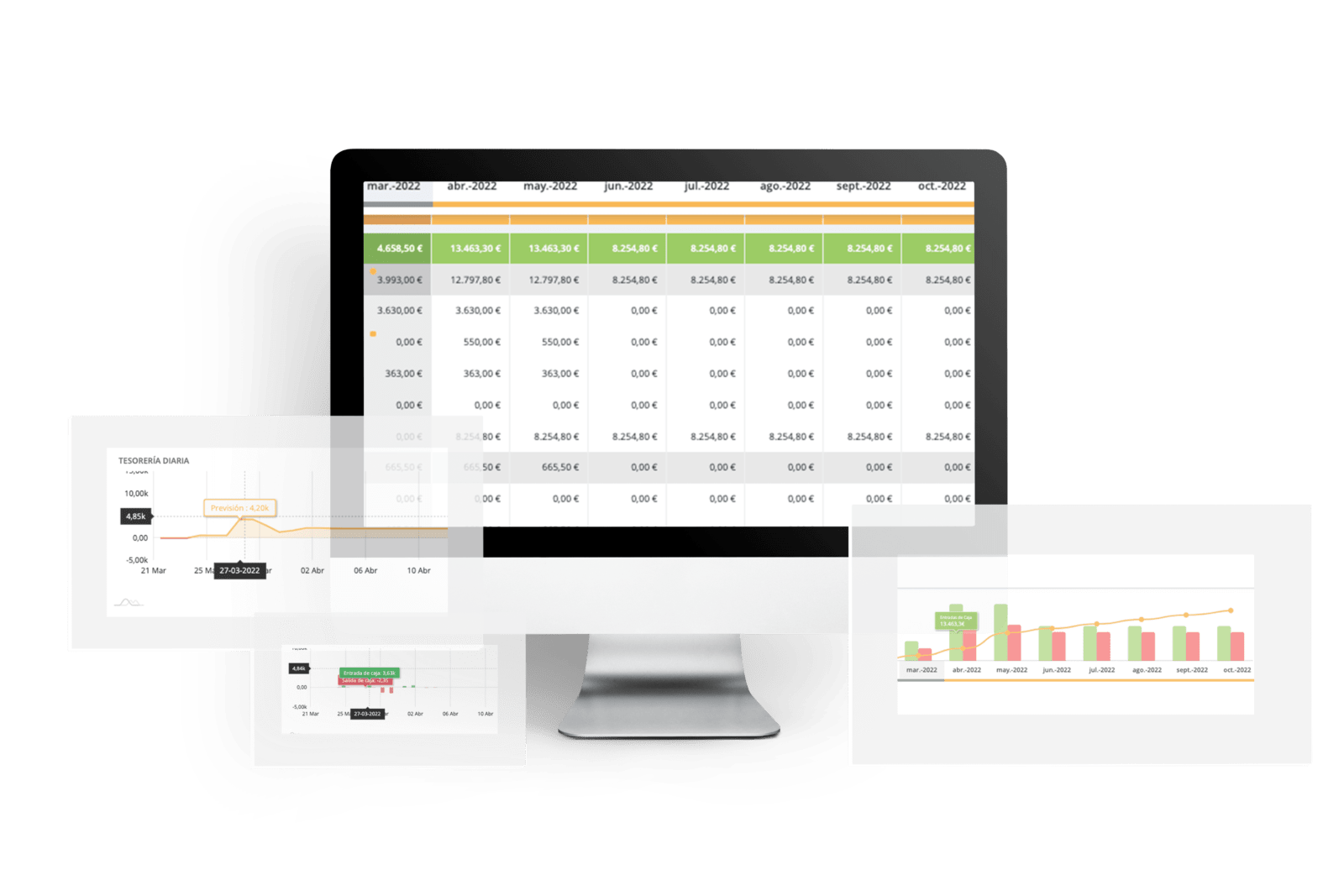The first thing to be clear about is that profit is not the same as cash. In this article we will explain why cash is more important than profit.
The profit in practice is: you make a sale for 100 €, it costs you 30 € to manufacture the product or perform the service, and therefore you get 70 € of profit.
Cash is different, why is cash more important than profit?
For product sales: In the case of a business that sells products, if you want to make that €100 sale, you will possibly need to have stock of the product you sell, and for that you must have previously purchased the product or the materials you use to manufacture it. If you have been able to buy 100 units at 30€ each, you must have already paid 3,000€ to make that first sale of 100€. Yes, this stock will serve you for the future, but in terms of cash, €3,000 has gone out and €100 has come in, and therefore you are already starting from a negative cash situation. Of course, the more sales you make, the more your cash situation will improve.
For the provision of services: The other situation is, for example, when you provide services. You make a sale but agree with your customers on 30-day payment terms, so you probably won’t get paid until the 30th day arrives, in some cases even later. Although you have generated the profit from the sale, the first euro has not yet come in, and therefore they are two completely different concepts.
You need to carefully manage both concepts, keeping in mind that cash is the lifeblood of any business, without it you will not survive or you will not be able to stay afloat for long.
How to identify possible future cash flow problems?
Your accountant or accounting software will provide you with great financial reports, but with a focus on Profit and Loss (P&L) and Balance Sheets of the business. These are financial reports that we must review calmly and understand what they are telling us, and not hesitate to ask our manager about anything we do not understand. But beware, these P&L reports will give us a view of the company that, as we have seen above, need not be similar to the view of a cash report.
Therefore, a third report is equally or even more important for day-to-day business, the cash situation. This is a report that you should review periodically as it will include all cash inflows and outflows, regardless of whether they affect the profit and loss account or not. It will give you a more accurate view of the business, as it will show you exactly what money has come in and what money has gone out at any given moment (including tax payments, loans…). This way you will get a very clear picture of exactly how much cash your business has improved, or how much cash you have overspent and where it has gone, whether to investments, debt repayment, etc.
How often should I check it?
Of course, it cannot be annually, but at least weekly, so that you can have time to correct what you consider before it is too late.
The cash report is perhaps the most important report on a day-to-day basis, telling you exactly what has happened in your business. It is understandable that you do not want to review the P&L and balance sheet on a weekly basis, but the cash flow should be reviewed on a very frequent basis.
What are the key points to review?
The most critical items you should check weekly, or even daily, are:
- The cash balance of your banks, reviewing the daily movements in and out. Remember, surprises when it comes to cash are usually not pleasant.
- The money you are owed, how much is pending to be collected in the coming days/weeks, and how much should have already been collected, so that you can act quickly and start claiming those amounts. It is convenient to make follow-up calls to your customers to understand why they have not paid, when they expect to be paid, to remember the payment terms agreed with them, the invoices to be paid in the next days or months…
And of course, conversely, how much money you owe your suppliers. - The payment of your loan/credit installments, which are obviously a cash outflow. On what date such payments are due and whether you will have sufficient cash to meet them.
If you are going to have a problem paying a supplier, pick up the phone and talk to them as soon as possible, explain what collections you are expecting from your customers and warn them that you will pay their invoice a few days later. It is very important to maintain open communication with both your customers and suppliers.
What is the origin of the cash flow problems?
Why is cash more important than profit?
If you have a cashbox problem, it may have been caused primarily by:
- Excess expenses: that your expenses are too high for the level of sales you currently have, one of the most common situations with the greatest impact on the cash flow of the business. The excess of small day-to-day expenses can end up being a serious problem. For example, subscriptions are very easy to sign up for, but you have to ask yourself whether the strategic ones really provide a differential vision of the business, or whether the operational ones save you a reasonable amount of time. On the other hand, it is common to tend to manually perform a process in excel instead of hiring a software that simplifies this task. This ultimately means that you are spending your time building and maintaining your own process, rather than paying for software to automate the process and using that time to make more sales.
Try to analyze the history of your company, the simple fact of analyzing each item will make you reflect on each of these expenses and conclude if they are really necessary or if they can be adjusted in some way. - Early payment: the terms of payment to your suppliers may be shorter than those of your customers, and this is penalizing your cash flow.
Try to give some of your attention to the payment terms when reviewing a new supplier’s contract. It may seem like a minor issue at the time, but without a doubt, and as you will have already understood during this post, it is an important issue that will affect the health of your business. - Late collection: you may be selling enough, but you are not managing to collect your invoices quickly and efficiently, and day-to-day expenses are eating into the company’s cash flow. Staying on top of your customers so that outstanding invoices do not get out of control is not a good thing, but that communication to understand the situation of your future receivables is vital to not only remember, but also adjust your forecasts if they are going to be delayed.
- Unexpected items: those small items that by themselves do not have a relevant amount, but as a whole represent a monthly payment to be taken into account. It is therefore important to analyze the past thoroughly and to establish budget items, however small, at least in an “others” bag. You should analyze historical bank movements and try to group them together to locate those “sacks” that may initially go unnoticed. It will be easier for you to estimate a future forecast of a grouping of expenses if you look at it as a whole in aggregate. Perhaps Orama can help you in this task with its automatic organization and classification of historical bank transactions.
- Taxes: good sales in recent months are likely to result in a higher than usual VAT assessment. Taxes are a very important item to take into account in cash budgets, and they are often not included, generating a big hole in the cash forecast. Remember to always include this item, it will never be superfluous to allocate a certain amount to avoid surprises (which we already know that in cash flow forecasts are not liked). There is no choice but to be very aware of the payments that will come in the coming months, ask your accountant if he can update the calculation of these taxes when you update your cash budget, and above all be aware that after a good month of sales is likely to come a “bad quarter” of VAT…
With the COVID situation, control of the company’s cash flow becomes crucial, but it does not take a pandemic to get the business under control. Everyone goes through complex situations every year, and understanding the impact on cash flow is the most important thing to know if the company will survive each small crisis.
Good planning helps to control complex situations. Therefore, the first thing we have to do is to have our numbers updated, and once they are up to date, plan for the future by creating projections of the cash inflows and outflows that our business will have in the coming year to obtain a fine-tuned cash forecast.
Want to go one step further? Simulates different scenarios
Once you are clear about your cash budget for at least the next 12 months, it is time to create scenarios to understand the best and worst case scenario and whether your business would survive the worst case scenario.
By simulating scenarios, you will be able to understand how the business will respond to different decisions, and thus visualize their impact before making them, often saving you significant costs and displeasure as a result of not having foreseen their impact on future cash flow.
Decisions such as hiring new personnel, or launching a new line of business can be projected as a scenario within your cash budget to understand how the company will absorb the cost, and whether the hiring/launch will result in a one-time cash shortfall for the company or whether there is no anticipated strain.
What about you? How do you control the cash flow of your business? Do you spend a lot of time with Excel, or do you use a tool that simplifies this control?





